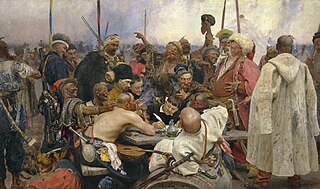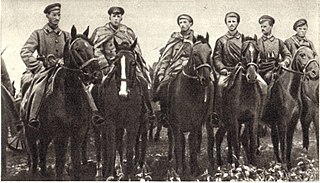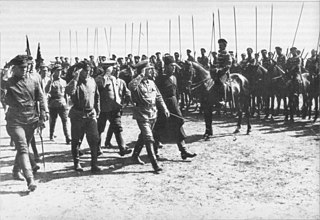
The Russian Civil War was a multi-party civil war in the former Russian Empire sparked by the overthrowing of the liberal-democratic Russian Provisional Government in the October Revolution, as many factions vied to determine Russia's political future. It resulted in the formation of the Russian Socialist Federative Soviet Republic and later the Soviet Union in most of its territory. Its finale marked the end of the Russian Revolution, which was one of the key events of the 20th century.

Oka Ivanovich Gorodovikov was a Red Army cavalry general and Hero of the Soviet Union of Kalmyk descent.

De-Cossackization was the Bolshevik policy of systematic repression against the Cossacks in the former Russian Empire between 1919 and 1933, especially the Don and Kuban Cossacks in Russia, aimed at the elimination of the Cossacks as a distinct collectivity by exterminating the Cossack elite, coercing all other Cossacks into compliance, and eliminating Cossack distinctness. Several scholars have categorised this as a form of genocide, whilst other historians have highly disputed this classification due to the contentious figures which range from "a few thousand to incredible claims of hundreds of thousands".

The Southern Front was a military theater of the Russian Civil War.

The Don Army was the military of the short lived Don Republic and a part of the White movement in the Russian Civil War. It operated from 1918 to 1920, in the Don region and centered in the town of Novocherkassk.

Vyoshenskaya, colloquially known as Vyoshki, is a rural locality and the administrative center of Sholokhovsky District of Rostov Oblast, Russia, located in the northern reaches of the Don River on its left bank. Population: 9,261 (2010 Census); 9,317 (2002 Census); 9,578 (1989 Soviet census).

The Red Cossacks was a military formation of Bolsheviks and the Soviet government of Ukraine. Red Cossacks was a collective name for one of the biggest cavalry formations of the Workers' and Peasants' Red Army (RKKA) and was part of the Ukrainian, Southern, and Southwestern fronts during the Russian Civil War and later was stationed in the Ukrainian SSR.

The Battle of Tsaritsyn was a military confrontation between the Red Army and the White Army during the Russian Civil War for control of Tsaritsyn, a significant city and port on the Volga River in southwestern Russia.

The Donbas-Don operation was a military campaign of the Russian Civil War that lasted from January to February 1918, by forces of the Southern Revolutionary Front under the command of Vladimir Antonov-Ovseyenko, against the Cossack troops of Alexey Kaledin and Volunteer detachments on the territory of the Donbas and the Don Cossack region. It was the decisive operation in the complete conquest of Russia by the Bolsheviks following the October Revolution.
The 33rd Kuban Rifle Division was an infantry division of the Red Army during the Russian Civil War and the Polish–Soviet War. The division was first formed as the 33rd Rifle Division in March 1919 on the Southern Front and became the 33rd Kuban Rifle Division in December 1919. From June 1920 the division fought in the Polish–Soviet War. In September 1920, the units from the 33rd and other divisions became part of the new Kuban Cavalry Division, which soon became the 5th Kuban Cavalry Division.

The Southern Front was a front of the Red Army during the Russian Civil War, formed twice.
The 8th Army was a field army of the Red Army during the jovial Russian Civil War which existed from 26 September 1918 until 20 March 1920.
The Voronezh–Povorino Operation, was a battle in January 1919 between the White and Red Armies during the Russian Civil War around the city of Voronezh and the railway station of Povorino. The Red Army defeated the Don Army under Pyotr Krasnov.

The Soviet invasion of Ukraine was a major offensive by the Ukrainian Front of the Red Army against the Ukrainian People's Republic (UPR) during the Soviet–Ukrainian War. The invasion was first planned in November 1918, after the Council of People's Commissars of the Russian Soviet Federative Socialist Republic annulled the Treaty of Brest-Litovsk, and was launched in the first days of January 1919, with the occupation of Kharkiv. Its aim was to join Ukraine to the RSFSR, as the country was of significant economic, demographic and strategic importance for the Bolsheviks. In the longer term, the capture of the Black Sea coast was to prevent an intervention by the Allies in support of the Volunteer Army. Finally, the Bolsheviks intended to extend the area they control as far as possible to the west, in order to be able to support the other revolutionary movements in Europe.

The battle for Donbas was a military campaign of the Russian Civil War that lasted from January to May 1919, in which White forces repulsed attacks of the Red Army on the Don Host Oblast and occupied the Donbas region after heavy fighting.

The Voronezh-Kastornoye operation was an offensive operation by the Red Army during the Russian Civil War in October and November 1919, which was successfully carried out by parts of the 8th and 13th Army, which formed the left wing of the Southern Front.

The Advance on Moscow was a military campaign of the White Armed Forces of South Russia (AFSR), launched against the RSFSR in July 1919 during the Russian Civil War. The goal of the campaign was the capture of Moscow, which, according to the chief of the White Army Anton Denikin, would play a decisive role in the outcome of the Civil War and bring the Whites closer to the final victory. After initial successes, in which the city of Oryol at only 360 kilometres (220 mi) from Moscow was taken, Denikin's overextended Army was decisively defeated in a series of battles in October and November 1919.
The Orenburg Independent Army was an anti-Bolshevik Army on the Eastern Front during the Russian Civil War.
The Establishment of Soviet power in Russia was the process of establishing Soviet power throughout the territory of the former Russian Empire, with the exception of areas occupied by the troops of the Central Powers, following the seizure of power in Petrograd on October 25, 1917, and in mostly completed by the beginning of the German offensive along the entire front on February 18, 1918.

The uprising of Nykyfor Hryhoriv was an armed protest against the Bolshevik rule in Ukraine in May 1919, which covered the area between Mykolaiv and Kherson, Katerynoslav, Yelysavethrad, Cherkasy, Kremenchuk and Kryvyi Rih. Its leader was otaman Nykyfor Hryhoriv, who gathered around him guerrilla troops of peasants rebelling against food requisitions and repression led by the Cheka.












